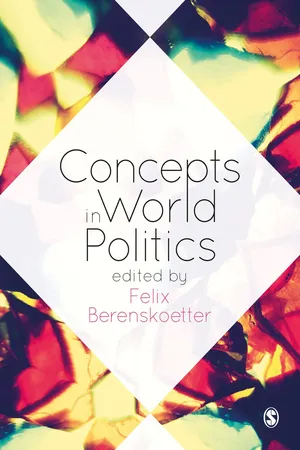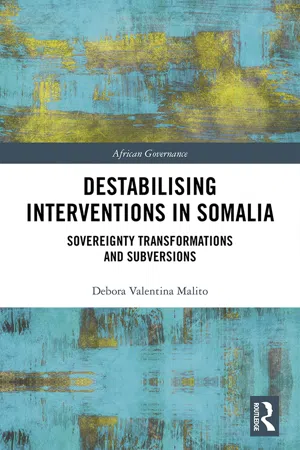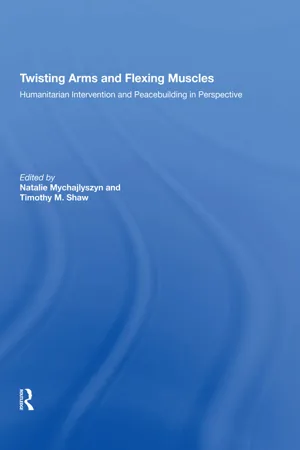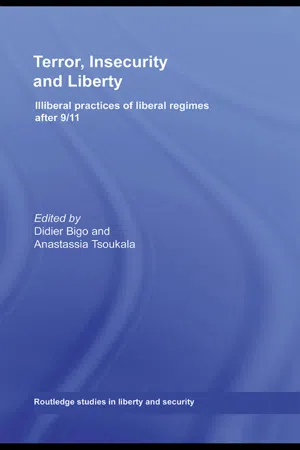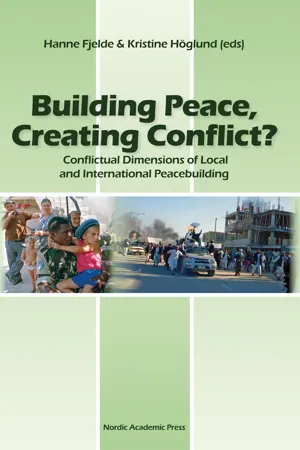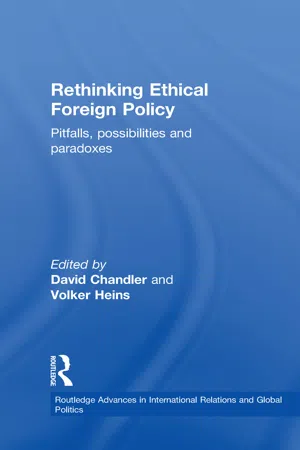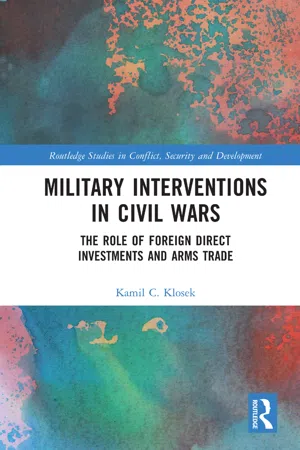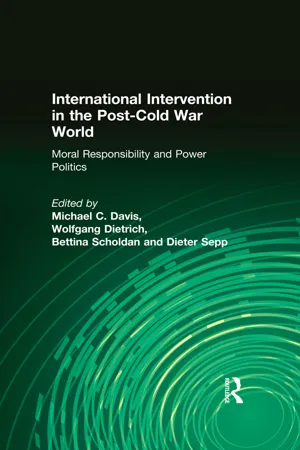Politics & International Relations
Western Intervention
Western intervention refers to the involvement of Western countries, particularly the United States and European nations, in the affairs of other countries. This involvement can take various forms, including military intervention, economic aid, or diplomatic efforts. Western intervention has been a subject of debate, with proponents arguing for humanitarian assistance and stability, while critics raise concerns about imperialism and neocolonialism.
Written by Perlego with AI-assistance
Related key terms
Related key terms
1 of 4
Related key terms
1 of 3
11 Key excerpts on "Western Intervention"
- eBook - ePub
Civil-Military Relations in International Interventions
A New Analytical Framework
- Karsten Friis(Author)
- 2020(Publication Date)
- Routledge(Publisher)
3Scholars have carefully and critically scrutinized many aspects of the interventions of the last decades, finding some successes but more often universalizing tendencies and neo-colonial implications.4 Interventions aimed at ‘saving strangers’5 or ‘fixing failed states’6 have been shown to be political endeavours. The Western promotion of such things as ‘good governance’, ‘best practices’, ‘gender equality’ and other human rights is found to be politically sensitive, even if these are represented as universal values, or downplayed as merely ‘technical advice’. The Western use of military force in so-called humanitarian interventions, stabilization operations, counterinsurgency, counter-terrorism and similar operations, have also been politically contested and critically examined by academics.This book focuses on one less researched aspect of the post-Cold War interventions, namely the relationship between the military and the various civilian intervening actors. This is an important relationship, because it is frequently claimed that success in interventions hinges largely on civil–military coherence.7 For example, we often hear that ‘there is no military solution’: that military force alone is incapable of resolving the conflict or winning a war, but must be coupled with political and other civilian efforts for there to be a sustainable victory or peace.8The twinning of military and civilian efforts is nothing new in the history of warfare. War has never taken place in a political vacuum: diplomacy has always been present in parallel with the fighting.9 Even in cases of crushing military victories and unconditional military surrenders, diplomatic activity has been an integral part of the process. Nothing is decided solely on the battlefield. Rather, the military have generally served as a tool for politicians and diplomats to strengthen their negotiating position towards each other. When the enemy has been weakened militarily, economically and socially, the conditions of the peace agreement tend to be more favourable for the stronger army.10 - eBook - ePub
- Felix Berenskoetter(Author)
- 2016(Publication Date)
- SAGE Publications Ltd(Publisher)
16 InterventionDavid ChandlerThis chapter seeks to analyse fundamental shifts in the concept of intervention since the end of the Cold War by tracing the political and ideational context through which the normative perception, function and performance of intervention has been transformed. It does this with the view, highlighted in the introductory chapter to this volume, that concept analysis is not so much concerned with changes in formal definitions as with the semantic fields within which a concept operates. Indeed, concepts can maintain their broad definitional “meaning” while being understood very differently in different socio-historical contexts. Complementing broader historical overviews, such as that by Reus-Smit (2013), this chapter shines light on shifts in Western understandings of the concept of intervention since the end of the Cold War in relation to both traditional disciplinary understandings of sovereignty in IR and to Western, liberal or modernist forms of knowledge. It thus adopts elements from both the historical and the political (critical) approach, highlighting changes in meaning over time and how these changes are embedded in Western foreign policies seeking to order the world, including understandings of conflict and effective forms of governance.In international law, intervention is a legal term for the use of force by one country in the internal or external affairs of another. In most cases, intervention is considered to be an unlawful act but some interventions may be considered lawful, as acts of self-defence or when supported by the UN Security Council to uphold international security. This chapter is not concerned with the legal debates surrounding this issue, not least because it holds that the traditional focus on military intervention must be complemented by an understanding of intervention through practices falling under the broad label of development. At a deeper level, this chapter shows how debates over international intervention have seen a shift from political concerns of sovereign rights under international law to concerns of knowledge claims of cause and effect highlighted through the problematisation of interventions’ unintended consequences. This can be illustrated by contrasting the difference between the confidence – today, critics would say “hubris” (Mayall and Soares de Oliviera, 2011) – of 1990s’ understandings of the transformative nature of external intervention and current, much more pessimistic, approaches. - eBook - ePub
Destabilising Interventions in Somalia
Sovereignty Transformations and Subversions
- Debora Valentina Malito(Author)
- 2019(Publication Date)
- Routledge(Publisher)
911). Economic, military and political external interventions in domestic politics are conventionally understood as pervasive and intrusive ways of regulating conflicts and cohabitation among unequal members of the International Community. There is a problem and ambiguity in the vocabulary employed in this study that needs a conceptual caveat. ‘International Community’ and ‘international intervention’ presuppose the existence of a post-national community that is founded on a common ethos and identity, where such an idea of commonality is the result of hegemonic elaborations on the moral superiority of capitalism, Western liberal democracy and human rights regimes. As they advance an idealised vision of a ‘common humanity’ (Newman, 2016, p. 32) that departs from and generalises ‘Western experience’ and ontological categories about political agency (Grovogui, 2005), they remain problematic. Cosmopolitan assumptions at the root of this elaboration see the construction of a global moral order as a viable solution to particularistic (national and geopolitical) interests, and to hegemonic and power competitions. Based on the assumption that the progress of a global moral order is universal and universally acceptable as it goes hand in hand with a decrease in competition and power inequalities, the construction of this moral order chimes with the fact that a globalised market economy does not necessarily reduce power contentions. The transcendence of nation states does not necessarily mean the transcendence of group and elite interests (Cox, 1997), and their role in shaping the global political architecture and economy. As power emerges and evolves alongside competition laws, the expansion of the global market or its institution will not reduce power competition (Palermo, 2016) but rather foment it - eBook - ePub
Twisting Arms and Flexing Muscles
Humanitarian Intervention and Peacebuilding in Perspective
- Timothy M. Shaw(Author)
- 2018(Publication Date)
- Routledge(Publisher)
Thus, this chapter addresses three questions: 1. What were the principal reasons for intervention during the Cold War? 2. How does contemporary intervention differ from the past? 3. What explains the differences between the two periods? The analysis begins with a discussion of the definitions of the principal terms followed by a review of the role of intervention in the international relations of the Cold War will be examined. The next part examines the evolution of the theory and practice of intervention after the Cold War. The chapter concludes with a discussion of the implications of the analysis for the dissonance between the global and the local in the contemporary international system. The primary argument is that the displacement of states by multilateral organizations, of strategic considerations by domestic politics, and the national interests by international standards is more apparent than real.As a note of clarification, given that there are several possible approaches to the study of intervention, (i.e. legal, ethical, political), this analysis considers intervention from the political point of view, whereby intervention is a coercive application of power which aims to modify the target’s action. The motivations of intervention can be self-interest in the traditional sense, or the pursuit of particular or universal norms and values. While intervention occurs within a reinforcing legal framework, this framework serves only to influence the direction and frequency of intervention, as will be explored more thoroughly in the following pages. But ultimately, intervention is a political phenomenon and it is regarded here as such.The Terms of the Debate
There are three important concepts in this analysis, the first of which is “global.” Global refers to a category of factors which function on the international level. They can be associated with a particular state (for example, American military power) or they can be extraterritorial (like the financial markets or the internet). They can be concrete, structural, institutional or subjective. For example, one could say that the structure of power (bipolarity, multipolarity, hegemony), the mechanisms of international economic trade, and the principles of human rights all have an important global dimension, meaning that they function on the global level. - eBook - ePub
Terror, Insecurity and Liberty
Illiberal Practices of Liberal Regimes after 9/11
- Didier Bigo, Anastassia Tsoukala(Authors)
- 2008(Publication Date)
- Routledge(Publisher)
6 Military interventions and the concept of the politicalBringing the political back into the interactions between external forces and local societies
Christian Olsson
The ‘global war against terrorism’ is the overarching rationale, if not the main motivation, of two major, international, but US-led, military interventions in Afghanistan since 2001, and in Iraq since 2003. These anti-terrorist interventions, although they both have been justified discursively or legally by ‘exceptional circumstances’, have in many ways challenged and changed our common understanding of the place of interventionist behaviour in international politics. But what is less frequently underscored, is that these interventions have seen major developments in military practices on the ground. The shift from ‘wars between states’ to ‘wars within states’ has highlighted the importance of the relation between intervening forces and local populations: the relational dimension of the political seems to prevail over the purely strategic relation of interstate war. One could have asked whether we are talking about wars at all (in the historical sense of the term), if it were not for the justification of these interventions by a ‘global war’, the long-term implications of which are still difficult to assess. Therefore any political analysis of these interventions would have to start with the concept of war. There are two ways of grasping the relation between the political and war.The first consists of analysing the political through the specific field of practices called politics.1 In this case, the central problem is to identify which one of the two fields of practices, politics or war, can be inferred from the other. Several classical insights can be mentioned here. In the Clausewitzian perspective, war as a practical reality – as opposed to war as a theoretical category – ought to be considered as ‘the continuation of politics by other means’. According to this insight, the political dimension of war is to be found in the political ends of which war is a means. In other words, the political refers to the ends, other than the military ends themselves of course that are pursued by war.2 Hence, in interstate wars, which are the ones that interest Clausewitz, the political refers to the state, or rather to the will and the practices of the professionals of politics, who speak and act in the name of the state. Michel Foucault has formulated a more provocative perspective in his analyses of the political theory of Hobbes. He simply reverses the first adage.3 - eBook - ePub
Building Peace, Creating Conflict?
Conflictual Dimensions of Local and International Peacebuilding
- Hanne Fjelde, Kristine Höglund(Authors)
- 2012(Publication Date)
- Nordic Academic Press(Publisher)
Such a world-view tends to assume that power operates through intentional domination, or more insidiously through persuasion, and hence that the intervener can affect the political authority in the target state in a top-down, zero-sum, and instrumental way. However, many would agree that interventional power actually functions in a two-way, messy, asymmetrical way. Perhaps in recognition of this, many post-Cold War interventions actively seek the cooperation and consent of host agents, especially, but not exclusively, host governments. 2 Lastly, we view external intervention as analytically distinct from other kinds of outsider–insider interface. An intervention is a special kind of response to the diagnosis of an ‘extraordinary’ and assumedly time-limited set of circumstances (conflict, underdevelopment, lack of governance, and so on) in which action is considered necessary for a delimited period of time. The action is not intended to be permanent, although there are cases where this is not straightforward. Intervention differs from governance, government, or policy, which constitute more ‘normal’, long-term actions. However, the dividing line is not crystal clear since interventions are not necessarily short-term and instead can be protracted, as would appear to be happening with the current military intervention by the US in Iraq. This example also illustrates the way in which governance and intervention may overlap; governance takes on the guise of intervention, or interventions become governance. Drawbacks of a top-down perspective The political world order in the twentieth century was dominated by the idea of the Westphalian nation-state, predicated in turn on national sovereignty, non-recognition of supranational authority, demarcated borders and non-interference in the internal affairs of individual states. The twenty-first century, however, has already seen a burgeoning of different forms of outside interference and intervention by non-state actors - eBook - ePub
- David Chandler, Volker Heins(Authors)
- 2006(Publication Date)
- Routledge(Publisher)
for the Other’: that the rights of a subject derived from ethical responsibilities to the Other (Lévinas, 1989:82). For Lévinas, ethics preceded politics and – in the formulation of putting responsibilities to the Other prior to the freedom of the Self – he inverted Schmitt’s conception of foreign policy-making and political identity. As David Campbell notes: ‘Lévinas’s thought is appealing for rethinking the question of responsibility … because it maintains that there is no circumstance under which we could declare that it was not our concern’ (Campbell, 1998b: 176). Putting responsibility before self-interest and ethics prior to politics fundamentally reworks traditional conceptions of foreign policy priorities.Western states and international institutions appear less as external or coercive forces and more as facilitators, empowerers and capacity-builders. This form of ethical foreign policy has obfuscated the projection of Western power – making the projection of power appear as an act of empowerment rather than of domination – and, in the process, has transformed the appearance of the international sphere from one of power, coercion and contestation into one where it appears that non-Western states have ‘ownership’ of policies that are externally imposed and where it is the poorest and most excluded sections of non-Western societies that are the agents of policy.More needs, less interests and less accountabilityWith the end of the cold war, questions were posed over the legitimization of Western hegemonic power in the international sphere. Security interests, so dominant in the cold war – in a clearly expressed struggle between two different superpower-led blocs with different ideological aims – waned as a justification for interventionist and regulatory frameworks through which the exercise of Western power could be articulated (see, for example, Laïdi, 1998). Problems of the articulation of a positive self-interest, as opposed to the expression of self-interest as a struggle for cold war survival, were difficult to address for Western political elites. Western governments and leading political parties had increasingly little connection with their own societies and were undergoing their own struggle to reconceive their political purpose and coherence in the wake of the crumbling political framework of Left and Right. In this context, a positive political programme that could allow Western elites to take political responsibility for their international dominance proved illusive. - eBook - ePub
Military Interventions in Civil Wars
The Role of Foreign Direct Investments and the Arms Trade
- Kamil C. Klosek(Author)
- 2021(Publication Date)
- Routledge(Publisher)
2 Understanding military interventions in civil warsDOI: 10.4324/9781003162087-2The international system
Civil wars generally take place within the confines of states. Hence, interventions are commonly understood as transgressions of territorial boundaries that are nominally under the sovereign control of a government. The first step in understanding military interventions in civil wars is to delineate the international political system based on the Westphalian order, which allows the concepts of civil war and intervention to exist in the first place. The Peace of Westphalia in 1648 was part of a political development that culminated over several centuries in the division of sovereignty over separated territories and people.1 The Westphalian peace treaties2 established two fundamental principles.3 On the one hand, the government of a state is solely responsible for matters of domestic politics and policies. Hence, the government is the only legitimate sovereign over people and territory. On the other hand, sovereigns of other states are prohibited from interfering in the domestic politics of another sovereign ruler. This explicit norm of non-interference in domestic affairs between states was carried through history until its codification in the UN Charter. In the wake of the Second World War and decolonization, the world became almost completely compartmentalized in territorial entities with separate political systems that uphold the fundamental norm of sovereignty.Notwithstanding the challenges faced by states to maintain sovereignty over their territory and people due to new norms of human security, the emergence of non-state actors, the scope of international institutionalization, and globalization processes, the fundamental entities that shape the structure of the international system continue to be states.4 The legitimacy to use violent means of power remains within the agency of countries acting in accordance with international law. For instance, the international economic trade system is determined by state negotiations on tariffs and bureaucratic barriers either in bi- or multilateral settings or through membership in international organizations like the European Union (EU ) or the World Trade Organization (WTO ). Only states can acquire membership, and states are responsible for taxation and welfare distribution on their territory. As Krasner5 - eBook - ePub
Western Military Interventions After The Cold War
Evaluating the Wars of the West
- Marek Madej(Author)
- 2018(Publication Date)
- Routledge(Publisher)
3 This was compounded by the temporarily strong position of the West as a whole. The West, including the US, was in ascendancy over the remainder of the world in an ideological, economic and strategic sense. An important role in this phenomenon was played by the transformation of NATO into an instrument capable of undertaking out-of-area operations, and the transformation of the European Community into the EU, which also started to exhibit ambitions to shape the international order in accordance with its interests and values. The confidence of the West was bolstered by the recent victory, also an ideological one, over the communist bloc. The international standing of the West was briefly strengthened by globalisation processes which were generated by Western economies, technology, finances, development and living (consumption) model, media (the Internet, CNN), export, investments. The West became the only reference point for the rest of the world and the world seemed open to the import of Western ideals and goods. The United States attempted to facilitate this process by partially ignoring the sovereignty of states located in other regions.At that time human rights became the ideological foundation for liberal interventionism. Since the beginning of the 1990s we have witnessed an absolutely unique expansion of these rights. Earlier, i.e. after World War II, they had been suppressed by the principal matter of security in West–East relations. The human rights issue attained a right of ‘citizenship’ in international dealings and Western states became their natural promoter. Perhaps the most emblematic question for international development in this field became humanitarian intervention. The Western doctrine of humanitarian intervention proclaimed the right (‘of the international community’) to military intervention in an event of a widespread and drastic breach of human rights or a humanitarian catastrophe in a given country. In essence it pertained to the use of force against the authors of such dramatic events – regimes, governments, dictators. It was accepted that in the face of atrocities such as the ethnic cleansing or genocide in the Balkans or in the African Great Lakes region, one cannot be idle. Criticism that intervention is undertaken solely by Western states burdened by mistreatment of subjugated peoples during colonial times was met by the argument that only they have the capabilities to undertake such operations.4 - eBook - ePub
International Intervention in the Post-Cold War World
Moral Responsibility and Power Politics
- Michael C. Davis, Wolfgang Dietrich, Bettina Scholdan(Authors)
- 2017(Publication Date)
- Routledge(Publisher)
Critics of intervention have focused on instances of humanitarian intervention where strategic or economic interests are involved. However, advocates for humanitarian interventions highlight that the more vexing problem is the lack of political will to intervene in parts of the world where geopolitical or business interests are not at stake. UN secretary-general Annan has been admonishing member states that “the collective interest is the national interest.” 124 The threat of global terrorism shows unequivocally that state-building, national security, and international security are highly interconnected. It is unfortunate that the world’s superpower remains averse to the notion of state-building—even in the case of Afghanistan. Apparently, although sovereignty has evolved from the right of territorial conquest to the norm of territorial integrity, its further transformation into the norm of humanitarian intervention still has a long way to go. Notes I would like to thank the Center for International Security and Cooperation at Stanford University for sponsoring the initial research and writing of this chapter. I also want to express my gratitude for faculty members of the Department of Politics and Public Administration at the Hong Kong University for their helpful comments. 1. Humanitarian justifications for forcible interventions are not new. See Martha Finnemore, “Constructing Norms of Humanitarian Intervention,” in Peter J. Katzenstein, ed., The Culture of National Security: Norms and Identity in World Politics (New York: Columbia University Press, 1996), pp. 153–185. However, “the idea that complex humanitarian disasters of the type experienced by Somalia and Liberia must… be the responsibility of the international community is a new phenomenon in international relations.” See Jeffrey Herbst, “Responding to State Failure in Africa,” International Security 21, no. 3 (Winter 1996–1997): 144. 2. Finnemore, “Constructing Norms of Humanitarian Intervention,” p - eBook - ePub
- Amitav Acharya(Author)
- 2014(Publication Date)
- Routledge(Publisher)
The debate about humanitarian intervention has been going on for decades. In 1992, a New York Times editorial noted: “In just a few years the idea has been established that countries which fail to care decently for their citizens dilute their claim to sovereignty and forfeit invulnerability to outside political–military intervention.” 22 Some writers had taken it much further, adding ecological and proliferation issues to the agenda of intervention. Laurence Martin, then President of the Royal Institute of International Affairs, had argued that despite the end of the Cold War, there would “remain substantial motives for the greater powers … to interest themselves in the third world,” because of the dangers of proliferation of weapons of mass destruction, migration caused by demographic pressures, and “moral concern for the welfare of fellow men.” To this, he would add “the current wave of enthusiasm for democracy and the market, lest failure should engender new authoritarian and potentially aggressive tendencies.” 23 Another writer has suggested “three classes of purpose warranting possible intervention”: intervention to prevent or stop the wide-spread violation of human rights (“humanitarian intervention”); intervention to halt the imminent and continued use of weapons of mass destruction, including chemical, biological, and nuclear weapons, perhaps borne by ballistic missiles (“security intervention”); and intervention to block or contain the release of materials causing severe and wide damage to the climate, landscape, or seascape (“environmental intervention”). 24 Yet, the war on terror’s challenge to sovereignty assumes a special significance that could not have been foreseen by the post-Cold War ideas about intervention. First, it links different types of reasons for intervention within its “axis of evil” formulation: bringing together sponsorship of terrorism, weapons of mass destruction and abuse of human rights as reasons for intervention
Index pages curate the most relevant extracts from our library of academic textbooks. They’ve been created using an in-house natural language model (NLM), each adding context and meaning to key research topics.
Explore more topic indexes
Explore more topic indexes
1 of 6
Explore more topic indexes
1 of 4

